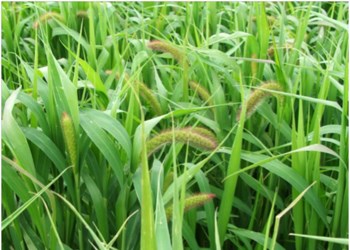Using annual forages to extend the grazing season is a common practice and millets are one of the options available to use for silage, greenfeed, or swath grazing. Millets can be grown in all soil zones of the province but perform best on well drained, south facing soils. Because they are a warm season crop, millets should be seeded in soils that have warmed up to least 10 degrees Celsius. Most of the growth will occur during the hottest summer months. Golden German Millet, a foxtail millet, takes between 70 to 90 days to heading and is generally higher yielding compared to proso millet, a crown millet, which takes around 60 to 65 days to heading. Proso millet can be a good option where late seeding is required, such as after a wet spring.
Seeding rates are 15lbs to 20lbs for proso and Golden German millet respectively. Millets should be fertilized according to soil tests and comparable to a crop grown for grain. The economics of using millets as an annual crop in forage production will vary based on seed cost and number of grazing days gained. Millet yields can vary considerably based on the length of the growing season and associated weather conditions. Under good growing conditions, millets do have the potential to out-yield oats or barley but may also fall short on yield if cool and moist growing conditions prevail.
Millets cut for silage are cut around early heading. Millets have a waxy leaf coat which makes them slow to dry down for greenfeed and therefore should be crimped or sprayed with glyphosate to speed up the dry down process. Millets for swath grazing are cut about two to three weeks after heading. Because of their late maturity and their ability to hold nutritional quality in part due to their waxy leaf coat, most millets are well suited for swath grazing. A study conducted at the Western Beef Development Centre reported good forage quality resulting in adequate grazing animal performance and good palatability of millet which lay in the swath for nearly 60 days prior to grazing. Feed testing millets is a good management practice as the warm season crops may be more prone to nitrate accumulation especially when a first frost occurs during lush plant growth.
Nadia Mori, PAg, Regional Forage Specialist
Saskatchewan Ministry of Agriculture
For more information, please contact:
•Your Regional Forage Specialist,
•Agriculture Knowledge Centre (1-866-457-2377) or
•Visit our website at www.agriculture.gov.sk.ca.




